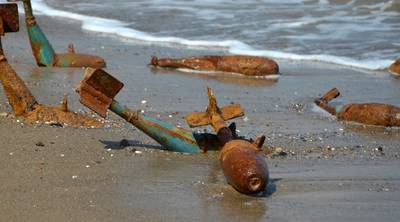Navigating a Minefield: Why UXO Could Hamper the UK’s Offshore Wind Ambitions
The UK’s plans to significantly increase offshore wind capacity to 50GW by 2030 risks being hindered by an array of undiscovered unexploded ordnance (UXO) in our coastal waters. It is estimated that up to 500,000 legacy items/targets of UXO could still be present in UK waters. These require safe removal or disposal to clear the way for accelerated offshore wind development. The current practice of High-Order UXO detonation (often resulting in a huge explosion) generates loud underwater (subsea) explosions which can disrupt navigation, migration, feeding and communication of marine mammals, fish and other wildlife.
The UK Marine Strategy aims to protect the marine environment and reduce noise levels by recommending alternatives to High-Order detonation. One such alternative is the Low-Order technique of using plasma jets to burn out munitions from inside the casing of a UXO. However, few realize that the Low-Order method will often result in sea pollution through the deposit of hazardous waste on the seabed and also carries a consequential risk of an unplanned explosion.
The lingering legacy of two World Wars
The UK plans to power every home from offshore wind by 2030. This will require the equivalent of one turbine to be installed every weekday for the next ten years – an unprecedented pace of offshore development. Building offshore windfarms, at this rate, will necessitate an accelerated clearance of UXO before construction can commence, to ensure the safety of assets and people. This will involve literally and figuratively navigating a minefield. 30% of sea mines and 10% of torpedoes and bombs from World War II are estimated to lie, unexploded, around UK waters, posing a threat to new offshore energy infrastructure. There are already an estimated 50 marine mine and bomb clearances each year and this will only accelerate as offshore wind construction picks up pace.
The conventional disposal method of High-Order detonation, involves placing a high-explosive disposal system to generate a targeted plasma jet or blast-fragmentation charge that destroys the item of UXO, creating a subsea explosion and blast /shock wave that ripples outwards in all directions. These loud explosions can lead to permanent hearing loss, mass stranding’s and deaths amongst whales and dolphins. Research found 88 ordnance explosions in the North Sea caused permanent hearing loss in 1,280 harbor porpoises.
A single mine clearance operation in Germany in 2019 generated noise exceeding the maximum level allowed across almost an entire marine conservation area, causing the deaths of 41 porpoises. The blast and shockwaves can be so severe that they can also damage nearby underwater flora and fauna. The UK’s Marine Strategy therefore recommends alternative methods of clearance to reduce noise levels below environmentally friendly limits. The UK government recently submitted a joint interim position statement further urging the development of alternative UXO clearance methods.
Alternative UXO clearance methods
We have recently seen growing pressure from UK Parliament to adopt alternative solutions for the disposal of UXO. One such method which could be used is a Low-Order technique. This involves a small metallic cone fired against the device, forming a plasma jet which causes its explosive contents to burn (deflagrate) the explosive filling from the inside. If successful, this can dispose of underwater UXOs without noisy explosions, yet few realize that this technique has a significant failure rate, and many potentially environmentally hazardous consequences. Furthermore, the poor condition of the majority of bomb and mine casings prosecuted, often results in holes or fissures in the casing being present which prevents pressure build up within the casing on which a successful Low-Order technique relies.
Should the casing be gas-tight, and if the burn rate produces sufficient heat and pressure within the casing to produce a detonation as opposed to an intended deflagration before the casing bursts, it can instead cause the very detonation it was designed to avoid. This potential consequence is unpredictable and once initiated, is unavoidable and unstoppable. Immersion in seawater desensitizes some explosives and prevents them burning as intended. In any discussion or debate on the subject, it is accepted by Military end-users that there is a 10% chance that a Low-Order technique disposal attempt will result in a High-Order detonation, which if the necessary mitigation elements have not been put in place, could have detrimental ripple effects across marine habitats.
Where the Low-Order technique is successful, a large proportion of the explosive filling and other components remain intact, leaving a large proportion of hazardous waste on the seafloor. This requires further costly and energy-intensive clearance for the remaining waste to be gathered and placed in a disposal stillage and disposed of using a clearing charge.
A low-yield alternative
There is an alternative new technique of UXO disposal which enables a UXO to be safely removed to accelerate offshore wind expansion without environmentally hazardous explosions and waste. In 2015 a Low-Yield technique was developed by EORCA (UK), JF Renewables’ exclusive partner. This pioneering technique simultaneously generates a singular or multiple high-pressure water jets which are targeted at the explosive contents and vulnerable internal components of a UXO without burning or blowing up the item of UXO. The result is an innocuous explosion of only 300grams as opposed to the 2.5kg to 10kg blast produced by High-Order explosive disposal techniques. This means it is much quieter, produces a far smaller shock wave and causes less disruption to nearby marine mammals, fish, flora and fauna.
EORCA UK’s Low-Yield technique leaves behind only tiny pieces of material, which are harmless in water and dissipate over time. Crucially, unlike the Low-Order technique, Low-Yield guarantees against any risk of an environmentally detrimental High-Order explosion. EORCA has completed multiple Low-Yield operations in the offshore wind sector with a 100% success rate, five of which were conducted during 2021 demonstrating the extraordinary potential of this pioneering technique to safely clear items of UXO to offshore energy infrastructure while protecting marine life.
Given the overwhelming benefits of the technique, it is expected to become more and more prevalently deployed in marine construction projects.
It is vital that the industry employs UXO techniques developed for the offshore market that are capable not only of paving the way for accelerated offshore wind development but also safeguarding our marine ecosystems. In demonstrating that UXO can be successfully cleared without producing loud blasts and excessive waste, the Low-Yield technique offers a truly sustainable path to safe offshore wind development and is exclusively available to JF Renewables.
This is a guest post, and the views and opinions expressed in it are those of the author(s). They do not necessarily reflect the views of Offshore Engineer Magazine.











